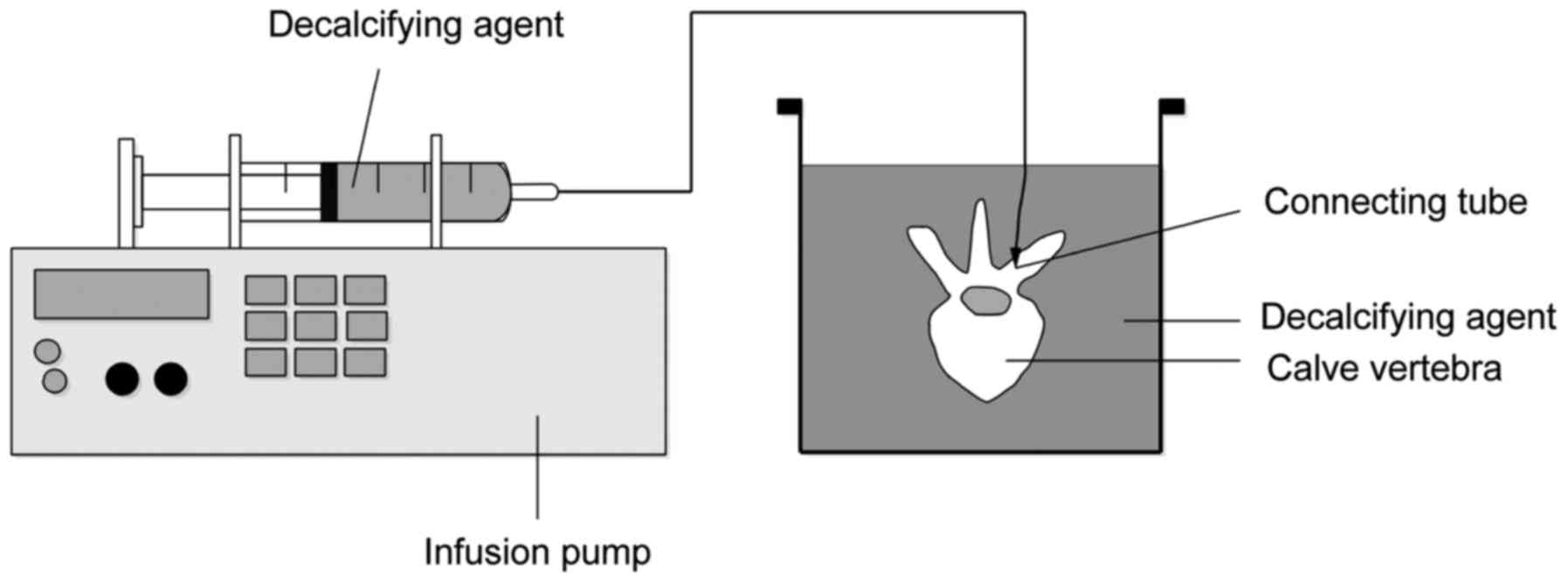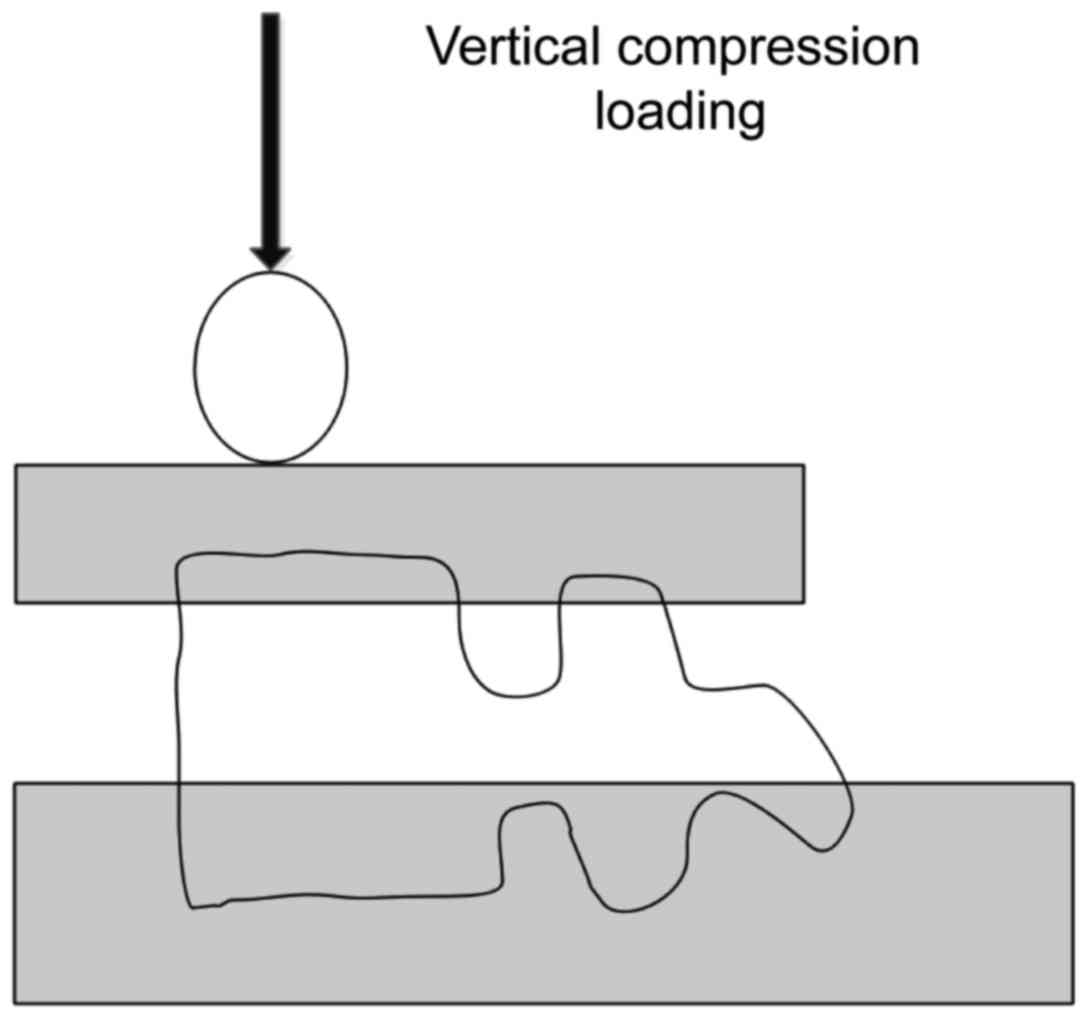|
1
|
Melton LJ and Kallmes DF: Epidemiology of
vertebral fractures: Implications for vertebral augmentation. Acad
Radio1. 13:538–545. 2006. View Article : Google Scholar
|
|
2
|
Oldenhuis CN, Oosting SF, Gietema JA and
de Vries EG: Prognostic versus predictive value of biomarkers in
oncology. Eur J Cancer. 44:946–953. 2008. View Article : Google Scholar : PubMed/NCBI
|
|
3
|
Tseng YY, Lo YL, Chen LH, Lai PL and Yang
ST: Percutaneous polymethylmethacrylate vertebroplasty in the
treatment of pain induced by metastatic spine tumor. Surg Neurol.
70 Suppl 1:S78–S83. 2008. View Article : Google Scholar
|
|
4
|
Taylor RS, Taylor RJ and Fritzell P:
Balloon kyphoplasty and vertebroplasty for vertebral compression
fractures: A comparative systematic review of efficacy and safety.
Spine. 31:2747–2755. 2006. View Article : Google Scholar : PubMed/NCBI
|
|
5
|
Azorit C, Hervas J, Analla M, Carrasco R
and Muñoz-Cobo J: Histological thin-sections: A method for the
microscopic study of teeth in Spanish red deer (Cervus elaphus
hispanicus). Anat Histol Embryol. 31:224–227. 2002. View Article : Google Scholar : PubMed/NCBI
|
|
6
|
Tomita S, Kin A, Yazu M and Abe M:
Biomechanical evaluation of kyphoplasty and vertebroplasty with
calcium phosphate cement in a simulated osteoporotic compression
fracture. J Orthop Sci. 8:192–197. 2003. View Article : Google Scholar : PubMed/NCBI
|
|
7
|
Boonen S, Wahl DA, Nauroy L, Brandi ML,
Bouxsein ML, Goldhahn J, Lewiecki EM, Lyritis GP, Marsh D, Obrant
K, et al CSA Fracture Working Group of International Osteoporosis
Foundation, : Balloon kyphoplasty and vertebroplasty in the
management of vertebral compression fractures. Osteoporos Int.
22:2915–2934. 2011. View Article : Google Scholar : PubMed/NCBI
|
|
8
|
Watts NB, Harris ST and Genant HK:
Treatment of painful osteoporotic vertebral fractures with
percutaneous vertebroplasty or kyphoplasty. Osteoporos Int.
12:429–437. 2001. View Article : Google Scholar : PubMed/NCBI
|
|
9
|
Mathis JM: Percutaneous vertebroplasty or
kyphoplasty: Which one do I choose? Skeletal Radiol. 35:629–631.
2006. View Article : Google Scholar : PubMed/NCBI
|
|
10
|
Lamy O, Uebelhart B and Aubry-Rozier B:
Risks and benefits of percutaneous vertebroplasty or kyphoplasty in
the management of osteoporotic vertebral fractures. Osteoporos Int.
25:807–819. 2014. View Article : Google Scholar : PubMed/NCBI
|
|
11
|
Zhao G, Liu X and Li F: Balloon
kyphoplasty versus percutaneous vertebroplasty for treatment of
osteoporotic vertebral compression fractures (OVCFs). Osteoporos
Int. 27:2823–2834. 2016. View Article : Google Scholar : PubMed/NCBI
|
|
12
|
Anselmetti GC, Muto M, Guglielmi G and
Masala S: Percutaneous vertebroplasty or kyphoplasty. Radiol Clin
North Am. 48:641–649. 2010. View Article : Google Scholar : PubMed/NCBI
|
|
13
|
Seven A, Yuksel B, Kucur S Kabil, Yavuz G,
Polat M, Unlu BS and Keskin N: The evaluation of hormonal and
psychological parameters that affect bone mineral density in
postmenopausal women. Eur Rev Med Pharmacol Sci. 20:20–25.
2016.PubMed/NCBI
|
|
14
|
Cho AR, Kim HK, Kwon JY, Kim TK, Choi YM
and Kim KH: The incorporation of platelet-rich plasma into calcium
phosphate cement enhances bone regeneration in osteoporosis. Pain
Physician. 17:E737–E745. 2014.PubMed/NCBI
|
|
15
|
Gao J, Mi S and Liu C: Treatment of
various kinds of osteoporotic vertebral fracture with vertebral
plasty. Chin J Bone Jt Inj. 24:35–37. 2009.(In Chinese).
|
|
16
|
Colangelo D, Nasto LA, Genitiempo M,
Formica VM, Autore G, Pambianco V, Tamburrelli FC, Cerulli G and
Pola E: Kyphoplasty vs conservative treatment: a case-control study
in 110 post-menopausal women population. Is kyphoplasty better than
conservative treatment? Eur Rev Med Pharmacol Sci. 19:3998–4003.
2015.PubMed/NCBI
|
|
17
|
Zarrinkalam MR, Beard H, Schultz CG and
Moore RJ: Validation of the sheep as a large animal model for the
study of vertebral osteoporosis. Eur Spine J. 18:244–253. 2009.
View Article : Google Scholar : PubMed/NCBI
|
|
18
|
Nayak S, Olkin I, Liu H, Grabe M, Gould
MK, Allen IE, Owens DK and Bravata DM: Meta-analysis: Accuracy of
quantitative ultrasound for identifying patients with osteoporosis.
Ann Intern Med. 144:832–841. 2006. View Article : Google Scholar : PubMed/NCBI
|
|
19
|
Egermann M, Goldhahn J and Schneider E:
Animal models for fracture treatment in osteoporosis. Osteoporos
Int. 16 Suppl 2:S129–S138. 2005. View Article : Google Scholar : PubMed/NCBI
|
|
20
|
Nakagi Y, Ito T, Hirooka K, Sugioka Y,
Endo H, Saijo Y, Imai H, Takeda H, Kayama F, Sasaki S, et al:
Association between lifestyle habits and bone mineral density in
Japanese juveniles. Environ Health Prev Med. 15:222–228. 2010.
View Article : Google Scholar : PubMed/NCBI
|
|
21
|
Kilincer C, Inceoglu S, Sohn MJ, Ferrara
LA, Bakirci N and Benzel EC: Load sharing within a human thoracic
vertebral body: An in vitro biomechanical study. Turk Neurosurg.
17:167–177. 2007.PubMed/NCBI
|
|
22
|
Giro G, Gonçalves D, Sakakura CE, Pereira
RM, Marcantonio E Júnior and Orrico SR: Influence of estrogen
deficiency and its treatment with alendronate and estrogen on bone
density around osseointegrated implants: Radiographic study in
female rats. Oral Surg Oral Med Oral Pathol Oral Radiol Endod.
105:162–167. 2008. View Article : Google Scholar : PubMed/NCBI
|
|
23
|
Shirke SS, Jadhav SR and Jagtap AG:
Methanolic extract of Cuminum cyminum inhibits ovariectomy induced
bone loss in rats. Exp Biol Med. 233:1403–1410. 2008. View Article : Google Scholar
|
|
24
|
Martin-Monge E, Tresguerres IF, Blanco L,
Khraisat A, Rodríguez-Torres R and Tresguerres JA: Validation of an
osteoporotic animal model for dental implant analyses: An in vivo
densitometric study in rabbits. Int J Oral Maxillofac Implants.
26:725–730. 2011.PubMed/NCBI
|
|
25
|
Fyhrie DP and Vashishth D: Bone stiffness
predicts strength similarly for human vertebral cancellous bone in
compression and for cortical bone in tension. Bone. 26:169–173.
2000. View Article : Google Scholar : PubMed/NCBI
|
















